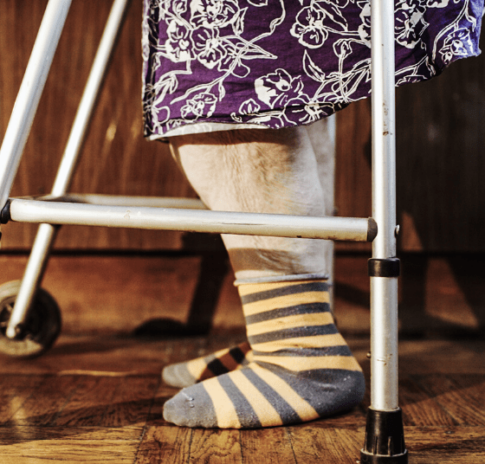According to the U.S. Centers for Disease Control and Prevention, falls are the most common cause of non-fatal trauma-related hospital admissions among older adults. The facts are alarming:
- Ninety-five percent of the 250,000 hip fractures that occur annually are the result of a fall.
- Every 11 seconds, an older adult is treated in an emergency room due to a fall.
- Every 19 minutes an older adult will die from a fall.
However, falls are often preventable. Our team at FirstLight Home Care has outlined the most common causes of falls in the elderly, as well as what to do to reduce the risk.
Be careful when carrying the load
- Never carry objects that are too heavy or large, making balance difficult.
- When carrying objects, do not allow your vision to be blocked.
- Make more trips with smaller loads.
Wear proper shoes
- Shoes should have low heels and good tread.
- Avoid smooth leather soles or tennis shoes with a smooth bottom.
- Keep shoelaces tied or Velcro firmly fastened.
- Slippers should have rubber soles and should not be worn outside.
Avoid common hazards around the home
- Area Rugs and runners should have a rubberized non-slip backing.
- Patterned rugs can affect depth perception. Solid-colored rugs are less confusing.
- Do not place cords or wires under rugs or runners. Uneven surfaces can cause tripping.
- Use non-slip rubber adhesives under furniture legs to prevent sliding.
- Shelves that are too high can result in a fall from overreaching or from using a chair or ladder.
- Do not use hallways or stairways for storage—keep them free of clutter.
- Tape down torn carpet and/or tack down loose edges.
Be aware of bedroom safety
- The bed should be a comfortable height, stable and firm enough to get in and out of easily.
- A telephone and lamp should be reachable on the bedside table.
- Keep a flashlight on the bedside table for emergencies.
- Eyeglasses, canes, and walkers should be kept within reach.
- Sit when dressing or undressing especially if you are unstable when standing.
Keep the bathroom safe
- Rubberized slip-resistant mats both inside and outside of the shower or tub help prevent slipping.
- Place slip-resistant grab bars inside and outside the shower and tub area and next to the toilet.
- Use a shower bench or chair for someone if unsteady on your feet.
- A raised toilet seat makes it easier and safer for someone who is weak or has balance problems.
Don’t forget proper lighting
- Light switches should be accessible at room entrances and at the beginning of any dark area.
- Always use the suggested maximum wattage (but not to exceed) of the light fixture.
- Consider frosted bulbs to reduce glare.
- Automatic touch lights that tum on when you touch the base of the lamp are helpful for those with arthritis or painful joints. Adapters are available to convert existing lamps into touch-sensitive lamps.
Stairs can also be a hazard
- Stairs should be well lit so that each step is clearly seen, especially the first and last step, the places where most falls occur.
- Check carpeted stairs regularly to make sure that the carpet is securely fastened.
- Do not place loose rugs or runners on the top or bottom of stair landings.
- All stairways, including outside stairs, should have handrails installed at the correct height on both sides.
Remember outdoor safety
- Step edges should be marked with reflective tape that is designed for outdoor use.
- Traction tape on stair treads will minimize the chance of falls when the stairs are wet.
- Use a contrasting color adhesive strip along the edge of the threshold to make it more visible.
- Keep pathways and stairs clean. Leaves, moss, snow, and ice can cause serious falls.
- Paths and sidewalks that are raised and cracked create a hazard.
- Illuminate pathways with exterior lights and light larger areas with spotlights.
- Keep hoses away from pathways and sidewalks.
Medications can contribute to falls
- Some medications can contribute to falls because of side effects such as drowsiness or dizziness.
- Review all medications with the physician or pharmacist to see if there is an increased risk for falls. Some drugs that contribute to falls are diuretics, blood pressure medicine and medications given for psychological reasons.
Walker and wheelchair safety
- When using a walker, both hands must be free to grasp the handles on either side.
- Avoid carrying heavy objects, which could cause a loss of balance or overload a wheelchair.
- Wheelchairs should be checked periodically to make sure they are in good working condition.
- Always raise or remove the foot supports and lock the wheels before transferring.
Emergency alarm systems provide peace of mind
- Personal Emergency Response Systems (PERS) provide emergency help at the press of a button, 24 hours a day.
- The response button is worn around the neck, on the belt or on the wrist.
- These systems help alleviate the fear of being alone during an emergency such as a fall.
At FirstLight, our caregivers are taught to watch for possible fall hazards and to manage them before an accident happens. In addition to home safety checks, our team provides a variety of home care services to help you or your loved one stay safe and independent.
Call your local FirstLight® Home Care today to learn more about how we can keep your loved one safe and happy at home.
